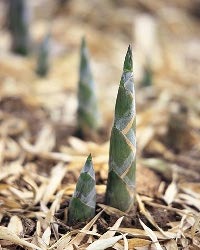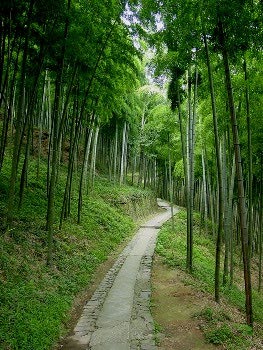How Is Bamboo Reproduced Without Seeds?
Dec 3, 2025, 9:20 AM
Flowering and fruiting is the characteristic of seeding plants, also including bamboo. It takes decades of years for bamboo to grow up,flower and fruit.After bamboo died, the seeds will fall into the ground and new bamboo shoot grows out.
Bamboo seeds are not similar as regular plant seeds which flower and fruit every year, so many people think bamboo doesn't flower and fruit or something wrong with temperature or earthquake. 2000 years ago, there is a record - Shan Hai Jing, which says "bamboo has flower, died after years".
There are 3 different species of bamboo in flowering.
One specie is flowering every year, like Ochlandra Thwait
One specie is flowering at irregular period, like Sinobambusa nephroaurita C.D.Chu et C.S.Chao, Bambusa multiplex Raeuschel ex J.A. et J.H.Schult.
One specie is flowering every 30 years or 80 years, like Dendrocalamus strictus Nees, Bambusa tulda Roxb.
Phyllostachys bambusoides Sieb. Et Zucc flowering every 120 years.
Known as the "green gold," bamboo is not only a material that can be used in many different ways, but it also represents resilience and sustainability. Bamboo's unusual method of reproduction, especially with regard to its seeds, is one of its most fascinating features. Bamboo, in contrast to many other plants, has an interesting life cycle that includes intermittent flowering and seed generation, which has a significant impact on its ecological role and ability to spread.
Despite appearing to be a straightforward plant, bamboo, which belongs to the grass family, has unusual reproductive characteristics. The majority of bamboo species only flower occasionally; some only produce seeds every few decades. Gregarious flowering is a phenomena that can cause entire groves to bloom at the same time, which is both an amazing sight and essential to the species' survival. Bamboo usually dies after this huge blossoming, but not before yielding a bountiful crop of seeds.
Bamboo seeds can withstand a wide range of environmental conditions because they are tiny, light, and usually covered in a protective layer. Given that the seeds can travel great distances on the wind, this adaptability is essential to their distribution. Even after the original grove has died, bamboo species will continue to exist thanks to their capacity to expand and colonise new regions. The delicate balance between life and death in nature is best illustrated by the lifespan of bamboo seeds.
Bamboo seed germination is an equally intriguing process. The seeds need particular circumstances to sprout after they arrive in an appropriate location. For bamboo seeds to flourish, the soil must be well-drained, warm, and moist. Bamboo seeds have a short viability period compared to many other plant seeds; if they are not planted, they may cease to germinate within a year. Bamboo seeds are time-sensitive, which emphasises how crucial the right environmental conditions are for their growth.
Because of its quick growth and capacity to store carbon, bamboo is frequently seen as a sustainable resource. However, relying solely on seeds to reproduce might provide difficulties, particularly in areas where habitat loss and climate change pose dangers to bamboo. The preservation of bamboo species and the protection of their distinctive reproductive systems are the main goals of conservation initiatives. As a result, bamboo seed banks and cultivation methods that encourage spontaneous regeneration are becoming more and more popular.
Bamboo's genetic diversity is one of its most important reproductive characteristics. Bamboo that blooms produces seeds that contain genetic material that can adjust to shifting environmental conditions. Bamboo populations depend on this genetic heterogeneity to be resilient and flourish in a variety of environments. To better understand how bamboo may be used in reforestation and land reclamation projects and strengthen its position as a sustainable resource, researchers are examining these genetic variations.
Beyond reproduction, bamboo seeds play an essential function in local ecosystems. Bamboo groves provide food and shelter for a variety of wildlife species. When the seeds fall to the ground, birds and other animals use them as a major source of food. Because bamboo habitats greatly contribute to biodiversity, their symbiotic relationship with wildlife emphasises how important it is to preserve them.
Bamboo seeds have symbolic importance in many cultures, frequently signifying growth, power, and tenacity. Bamboo's cyclical growth from seed to mature plant appeals to agricultural communities that use it for a variety of products, such as building, crafts, and food. This cultural significance highlights the importance of comprehending and protecting bamboo's reproductive activities so that this amazing plant can continue to benefit future generations.
Bamboo's significance in sustainable development is growing as the globe struggles with environmental degradation and climate change. Bamboo is a popular choice for environmentally friendly building and landscaping because of its rapid growth and carbon-sequestration capabilities. Communities may use bamboo's ability to address environmental issues and boost local economies by encouraging its production and maintaining the health of its seed populations.
Our methods for propagating bamboo seeds are likewise being impacted by scientific and technological developments. To increase bamboo cultivation's efficiency, methods including tissue culture and seed banking are being investigated. In regions impacted by deforestation or other ecological disturbances, these techniques can help guarantee that bamboo's genetic variety is maintained and that seeds are accessible for replanting.
Promoting the value of bamboo and its seeds requires a strong emphasis on education and awareness. People might be empowered to take part in conservation efforts through community programs that teach sustainable bamboo planting techniques. Local communities may take care of their surroundings and develop a stronger bond with nature and sustainable practices by learning the value of bamboo seeds.
The process by which bamboo seeds reproduce is evidence of the intricacy and splendour of the natural world. Bamboo's life cycle, from seed distribution to germination and growth, serves as an example of how ecosystems are interconnected and how important biodiversity is. Knowing how bamboo reproduces will be essential to maintaining its sustainability for upcoming generations as we continue to investigate its many advantages.

Bamboo shoot

Bamboo forest

 皖公网安备 34180202000049号
皖公网安备 34180202000049号